Steady flow
Steady flow: the velocity of a fluid particle changes with the position.
In the field of steady flow, devices are particularly suited to teaching measurement of the flow course, pressure distribution and velocity distribution.

Measurement of laminar and turbulent flow
Learning objectives/experiments
- representation of the flow profile
- determination of local and averaged flow velocity
- effect of the Reynolds number on the flow profile
- recognise differences between laminar and turbulent flow formation
- pipe friction / shear stress
….
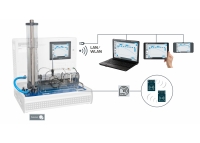
Recording the trajectory of the water jet and discharge coefficients at different outlet velocities
Learning objectives/experiments
- investigate how the level in the tank affects the outlet velocity
- apply Bernoulli’s equation
- compare determined and theoretical outlet velocity
- investigate outlet inserts with different diameters and inlet contours, determine pressure loss coefficients
- investigate how the outlet velocity and the pressure loss coefficient affect the trajectory of the water jet
….

Experiments on water flow in open flumes and in pipes, transparent design allows observation of the flow processes
Learning objectives/experiments
- fundamentals of pipe flow and open-channel flow
- differential pressure measurement at the orifice, Venturi nozzle, pipe bends and pipe angles, contraction and enlargement
- investigation of weir structures in an open channel
- in conjunction with the power meter HM 240.02
- recording a pump characteristic
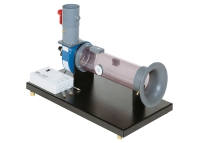
Recording the fan characteristic
Learning objectives/experiments
- recording a fan characteristic
- in conjunction with the power meter HM 240.02
- determining the fan efficiency
….
- determining the fan efficiency

Electrical power consumption of a consumer
Learning objectives/experiments
- measurement of the power consumption of a fan
- measurement of the power consumption of a pump
- determination of the related characteristic curve
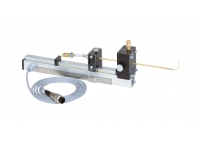
Measurement of the velocity distribution in the intake tube on HM 240
Learning objectives/experiments
- in conjunction with HM 240
- measurement of the total pressure and the static pressure in HM 240’s intake pipe
- recording pressure distribution over the cross section
- determining velocity distribution over the cross section
- in conjunction with HM 240.04
….

Cylinder in transverse incident flow; record pressure distribution in the wake of the cylinder in conjunction with HM 240.03
Learning objectives/experiments
- in conjunction with HM 240
- measurement of the pressure distribution around a cylinder subject to transverse incident flow
- in conjunction with total pressure sensor HM 240.03
- measurement of the total pressure in the wake of a cylinder
- determine drag coefficient from the pressure distribution in the wake of a cylinder
….

Measurement of pressure losses in straight pipe sections, in a 90° pipe bend, and in a 90° pipe angle
Learning objectives/experiments
- in conjunction with HM 240
- measurement of pressure losses in
- straight pipe sections
- a 90° pipe bend
- a 90° pipe angle
….

Investigation of heat transfer from a heated rod to an air flow
Learning objectives/experiments
- in conjunction with HM 240
- recording a cooling curve
- determining the heat transfer coefficients from the cooling curve

Determining pressure loss and velocity profiles; different measuring objects
Learning objectives/experiments
- experiments in the field of steady, incompressible flows by means of different measuring objects:
- calculation of the flow rate and the flow velocity
- recording the different velocity profiles in both the free jet and the pipe cross-section
- representation of the pressure loss in the system characteristic
- representation of the pressure loss at different pipe elements

Examination of the continuity equation and Bernoulli's principle; representation of the pressure curve
Learning objectives/experiments
- examination of the continuity equation and Bernoulli’s principle
- determination of the dynamic pressure
- calculation of the flow velocity
- representation of the pressure curve as a function of the cross-sectional area

Velocity distribution and boundary layer thickness within the boundary layer of a flat plate in longitudinal flow; vertically sliding Pitot tube
Learning objectives/experiments
- investigation of the boundary layer on a flat plate
- representation of velocity profiles

For experiments from the fields of flow around bodies and steady incompressible flow
Learning objectives/experiments
- together with appropriate accessories: experiments from the field of flow around bodies
- velocity measurement of flows with Pitot tube
- boundary layer analysis on a flat plate with flow along the plate
- drag of bodies
- demonstration of the Coanda effect
….

Demonstration of the continuity equation and Bernoulli's equation
Learning objectives/experiments
- investigation of the continuity equation and Bernoulli’s principle
- determination of the dynamic pressure from the measurement data via Bernoulli’s principle
- calculation of the flow velocity from the measurement data using Bernoulli’s equation
- pressure and velocity distribution

Determination of the static pressure at 29 pressure measuring points
Learning objectives/experiments
- investigation of the pressure curve at a 90° pipe bend
- determination of the static pressure at 29 pressure measuring points
- representation of the pressure distribution

Investigation of flow from nozzles
Learning objectives/experiments
- recording the pressure curve at the outlet of a parallel flow into resting surroundings
- representation of velocity profiles
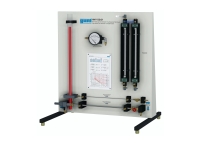
Determining the critical Reynolds number
Learning objectives/experiments
- measurements of the pressure loss in laminar flow
- measurements of the pressure loss in turbulent flow
- determining the critical Reynolds number
- determining the pipe friction coefficient
- comparing the actual pipe friction coefficient with the theoretical friction coefficient
In gases there is a difference between flow at constant volume (incompressible) and flow with varying volume (compressible). For larger changes in the fluid’s pressure and temperature the interconnections between pressure, temperature and volume may not be ignored any more. This flow is called compressible.
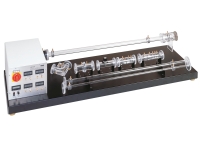
Subsonic and sonic flow through different measuring objects
Learning objectives/experiments
- pressure losses in pipes and pipe elbows
- flow in convergent/divergent nozzles
- determine the speed of sound in air
- compare calculation methods for incompressible and compressible flow
- use complete continuity equation
….

Schlieren optics for visualisation of Mach lines and shock waves on drag bodies; interchangeable walls in the measuring section produce velocities up to Mach 1,8
Learning objectives/experiments
- pressure curves in supersonic nozzles (Laval nozzle)
- pressure curves and losses in tunnel flows with Mach >1
- observe shock waves in drag bodies using Schlieren optics
- determining the Mach number from the angle of the shock waves
- comparison of theory and experiment

Measuring the impact or thrust force for determining the discharge velocity and the nozzle efficiency
Learning objectives/experiments
- determining the critical pressure ratio
- demonstration of the “choking effect”
- determining flow velocity in the narrowest cross-section
- measurement of the reaction or action force of the flowing fluid
- determine nozzle efficiency by thrust

Measuring the pressure curves in a convergent nozzle and in Laval nozzles
Learning objectives/experiments
- pressure curve in
- de Laval nozzles
- convergent nozzles
- connection between inlet pressure and mass flow rate or exit pressure and mass flow rate
- how pressure drop in the nozzle affects the temperature
….
Pipe systems are generally used to transport fluids. When flowing through a pipe the friction causes the pressure energy of the fluid to fall and the internal energy of the fluid to increase.
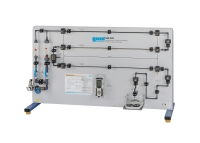
Resistances and losses in laminar and turbulent pipe flow
Learning objectives/experiments
- pressure losses for laminar and turbulent pipe flow
- determination of the friction factor for different pipe materials and diameters (Darcy-Weisbach equation)
- pressure loss in one or several pipe angles
- study of the jet force
- function of an orifice plate flow meter
….

Influence of flow velocity on pressure loss, didactically successive pipe sections
Learning objectives/experiments
- pressure losses in pipes, pipe fittings and pipe elements
- how flow velocity affects pressure loss
- application of Bernoulli’s equation
- determine resistance coefficients
- opening characteristics of valve and ball valve
….

Pipe friction for laminar / turbulent flow, Reynolds number and pipe friction factor
Learning objectives/experiments
- using the Reynolds number in pipe flow
- determine critical Reynolds number
- calculate the Reynolds and pipe friction coefficient from measured data
- compare theoretical values with measured values
- investigate the influence of temperature
….

Friction losses in the inlet as well as with different pipe geometries and surface roughnesses
Learning objectives/experiments
- formation of the flow along the inlet section
- difference between hydraulically smooth and rough pipes
- difference between round pipe and rectangular cross-section
- distinction between laminar and turbulent flow
- determine pressure loss in laminar flow / turbulent flow
….

Influence of flow velocity on pressure loss
Learning objectives/experiments
- pressure losses in pipes, piping elements and fittings
- how the flow velocity affects the pressure loss
- determining resistance coefficients
- opening characteristics and KVS values of angle seat valve and gate valve
- familiarisation with various measuring objects for determining flow rate:
….

Pressure losses in various pipe fittings and in the ball valve
Learning objectives/experiments
- investigate pressure losses and loss coefficients at
- segment bend and bends
- contraction and enlargement
- a ball valve
- determination of a pipe characteristic
….

Pressure losses at various piping elements and pipe networks; parallel and series connection of pipe sections
Learning objectives/experiments
- recording the calibration curve for pipe sections: pressure loss over flow rate
- pipe sections connected in parallel
- pipe sections connected in series
- combined series and parallel connection
- investigation of a closed circular pipeline
….

Interchangeable measuring objects and different pipe sections
Learning objectives/experiments
- flow and pressure measurement methods
- function of nozzle, orifice, Venturi nozzle
- losses due to pipe bends and pipe angles, changes in cross-section and shut-off valves and fittings
- determining pipe friction factors and resistance coefficients
- opening characteristics in shut-off valves and fittings

Investigation of flow and pressure losses in different pipe sections
Learning objectives/experiments
- different methods of differential pressure measurements
- influence of pipe diameters, different materials and surface roughness
- effect of the flow velocity
- pressure loss in pipe bends, pipe angles and segment bends
- pressure losses in cross-section changes
….

Experimental determination of important coefficients related to pressure loss in various pipe systems
Learning objectives/experiments
- fundamentals of flow measurement
- fundamentals of pressure measurement
- determination of the friction factor for different pipe materials and diameters
- resistance coefficients of pipe bends, enlargements and contractions
- pressure losses and opening characteristics of valves and fittings
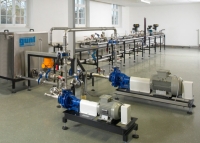
Investigations on centrifugal pumps, control valves, piping and fittings. Large scale industrial components and high-quality instrumentation deliver realistic measurement results.
Learning objectives/experiments
- experiments with pumps, valves and fittings and pipe sections
- operating behaviour of centrifugal pumps in individual or parallel operation
- measurement of the NPSH value of pumps
- pressure losses in pipe sections with different surface roughness
- pressure losses in pipe fittings
….

Investigation of the pressure difference in four equal-length pipe sections made of different materials
Learning objectives/experiments
- investigation of the pressure losses of flow through pipes
- measurement of the pressure differential on different pipe sections
- influence of various pipe diameters
- influence of different materials and surface roughness
- effect of the flow velocity
….

Investigation of the pressure loss at pipe elements with different changes in pipe direction and materials
Learning objectives/experiments
- flow measurement
- differential pressure measurement
- effect of flow and surface roughness
- effect of the flow velocity
- effect of changes in pipe direction

Determining the pressure loss in an open pipe section
Learning objectives/experiments
- hydrostatic pressure
- flow pressure
- pressure loss
- representation of pressure curves
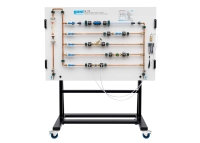
Investigation of the pressure loss of standard valves and fittings
Learning objectives/experiments
- pressure losses in valves and fittings
- measuring the pressure difference
- effect of the valve orifice shape on the pressure loss
- effect of the flow velocity
- determination of resistance coefficients
….

Investigation of pressure losses at contractions, pipe angles, pipe bends, valves and fittings and pipe elements
Learning objectives/experiments
- pressure curve in a closed pipe system with circulation pump
- influence of pipe diameter, flow velocity, change in cross-section and pipe fittings on the pressure losses
- determination of pump characteristics, system characteristics and the operating point
Special emphasis on technical issues:
- constructions
- valve characteristics
- Kvs values

Design and function of control valves; determination of the Kv value
Learning objectives/experiments
- together with control valves RT 390.01 – RT 390.06
- demonstration and functional testing of control valves
- determination of Kv and Kvs values
- plotting valve characteristics
- dynamic response of control valves: plotting step responses
….

Recording characteristic curves of industrial fittings and a centrifugal pump
Learning objectives/experiments
- characteristics of a centrifugal pump
- behaviour during operation and function of
- ball valve
- butterfly valve
- shut-off valve
….
When liquids flow, flow processes may cause local pressures that are smaller than the corresponding vapour pressure of the liquid. In this case, the liquid evaporates and vapour bubbles are formed. When the pressure re-increases the vapour bubbles implode.

Visualisation of cavitation effects in a transparent pump; how speed, inlet pressure, flow rate and temperature affect cavitation
Learning objectives/experiments
- formation of cavitation
- observation of cavitation effect
- how speed, inlet pressure, flow rate and temperature affect cavitation

Visualisation of the formation of vapour bubbles in a Venturi nozzle
Learning objectives/experiments
- function of a Venturi nozzle
- pressure as a function of the flow rate
- cavitation processes at different flow rates and pressures
Open-channel flow involves, amongst other things, the management of watercourses for the purpose of navigability, damming of lakes for power generation and/or storage of drinking water and flood protection measures.

Flow processes on different structures in open and closed channel flows; losses at inlet and outlet
Learning objectives/experiments
- open channel
- flow over control structures: broad-crested weir, narrow-crested weir, ogee-crested weir with ski jump spillway, sill
- discharge under a gate
- hydraulic jump
- closed channel
….

Experimental section for performing flow experiments in open flumes with lengths of 2,5m or 5m available, closed water circuit and inclination adjustment
Learning objectives/experiments
- together with optionally available models
- uniform and non-uniform discharge
- flow formulae
- flow transition (hydraulic jump)
- energy dissipation (hydraulic jump, stilling basin)
….

Flow around various drag bodies and incident flow of weirs
Learning objectives/experiments
- energy levels of the water when flowing through a flume with different obstacles
- investigation of the hydraulic jump
- Venturi flow rate measurement
- energy dissipation in the flume
….

Discharge measurement in open channels using two measuring weirs
Learning objectives/experiments
- free overfall at the sharp-crested weir
- plate weirs as measuring weirs
- determining the discharge coefficient
- comparison of measuring weirs (Rehbock, Thomson)
- determining the discharge
….

Flow around various drag bodies and incident flow of weirs; ink as contrast medium
Learning objectives/experiments
- how differently shaped weirs affect the flow
- visualisation of streamlines for flow incident to a weir
- visualisation of streamlines when flowing around various drag bodies
- supercritical and subcritical flow
….







